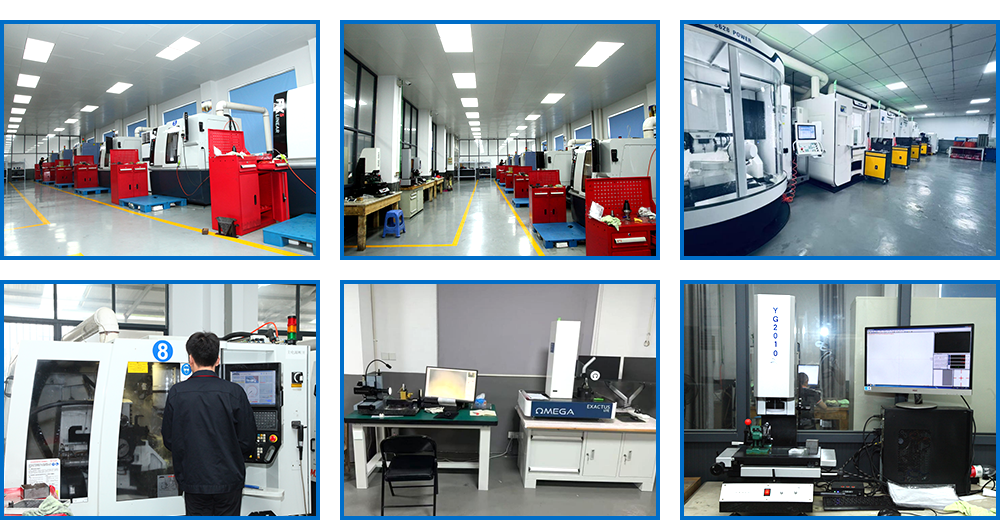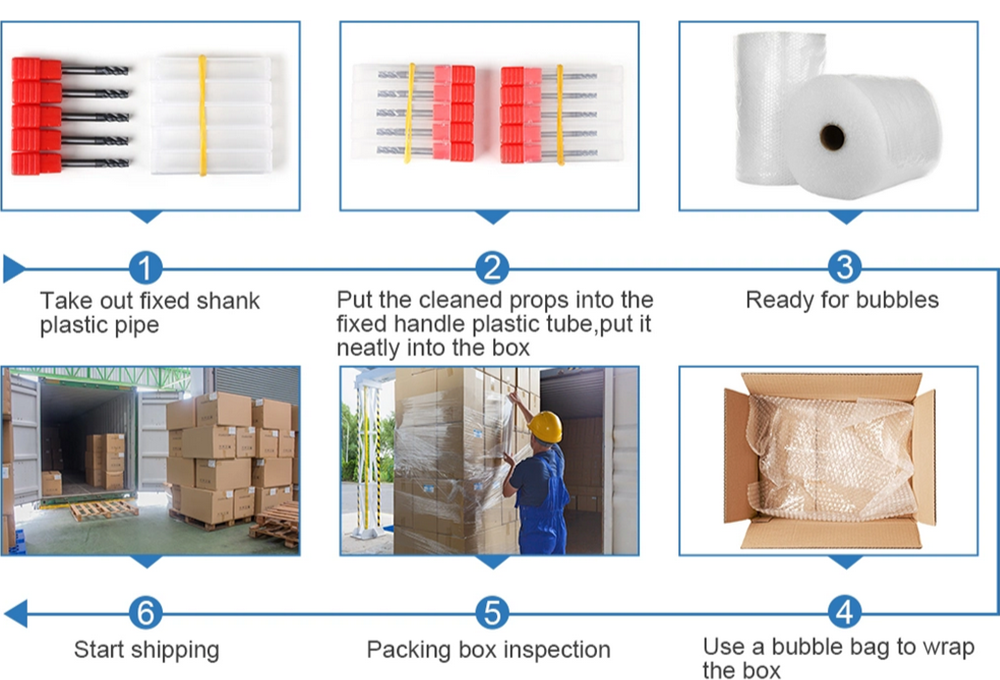English
- All
- Product Name
- Product Keyword
- Product Model
- Product Summary
- Product Description
- Multi Field Search
| SKU: | |
|---|---|
| Availability: | |
| Quantity: | |
HRC62 Carbide End Mills
We specialize in manufacturing high-performance HRC62 coated milling cutters. These tools are made from premium stainless steel and are designed to handle hard materials with a hardness of up to HRC62. The advanced coating on the cutters not only improves wear resistance but also enhances cutting efficiency, reducing heat generation and extending tool life. Our HRC62 milling cutters are ideal for high-speed milling applications and offer precision, durability, and reliability, making them the perfect choice for demanding machining tasks.
Materials Suitable for Machining
Precision and semi-precision machining of materials such as mold steel (up to HRC55) and cast iron.

Show Details

Specitications
| SIZES(D*fL*sD*L) | |
| D1*3*D4*50L | D5*(13/20/25)*D5*(50/75/100)L |
| D1.5*4.5*D4*50L | D6*(15/24/30*D6*(50/75/100)L |
| D2*6*D4*50L | D8*(20/30/35)*D8*(50/75/100)L |
| D2.5*7.5*D4*50L | D10*(25/40)*D10*(75/100)L |
| D3*9*D4*50L | D12*(30/45)*D12*(75/100)L |
| D3*(9/12/15)*D3*(50/75/100)L | D14/D16/D18/D20/D25*100L |
| D4*(10/16/20)*D4*(50/75/100)L | D6/D8/D10/D12/D14/D16/D18/D20*150L |
Advanced TiAlCrN Nano-Coating
Proprietary PVD-applied TiAlCrN (Titanium Aluminum Chromium Nitride) nanocomposite coating delivers exceptional heat resistance (up to 900°C) and oxidation resistance, significantly reducing friction coefficients. This extends tool life by 3× compared to standard AlTiN coatings when machining hardened steels (HRC 58-62), stainless steels, and nickel alloys.
Nano-layered structure enhances adhesion to the carbide substrate, preventing premature delamination under high-stress conditions.
Ultra-Fine Micrograin Carbide Substrate
Utilizes 0.2–0.5μm micrograin tungsten carbide with 12% cobalt binder, optimized for fracture resistance and edge stability. This eliminates micro-chipping during interrupted cuts in high-hardness applications like die-casting molds or aerospace components.
Anti-Vibration Geometry
Proprietary asymmetric helix (35°/45°) and variable pitch design disrupt harmonic resonance, reducing vibration by 70% in deep-cavity machining (e.g., >16mm pocketing). Combined with chamfered cutting edges, this prevents tool deflection and workpiece chatter.
| Parameter | Value |
|---|---|
| Diameter Range | 1–20mm (±0.003mm tolerance) |
| Flute Count | 3–4 flutes (45° helix) |
| Coating | SUPSTEED TiAlCrN Nano |
| Shank Type | Precision-ground Weldon |
| Length Options | 50mm, 75mm, 100mm, 150mm |
Aerospace: Slotting Inconel 718 turbine blades (HRC 45+) at 120m/min feed, dry machining.
Medical: Mirror-finishing surgical implant grooves (CoCr alloys, HRC 60) with Ra<0.2μm surface quality.
Tool & Die: High-efficiency roughing/finishing of HRC 62 DC53 die steel at 0.1mm stepdown, 4mm DOC.
Full Toolbody Polishing: Every end mill undergoes proprietary electrolytic passivation, smoothing flute surfaces to minimize chip adhesion and improve chip evacuation by 40% in gummy materials.
Non-Standard Sizes: Custom diameters (e.g., D4.37mm for hydraulic valve ports) and extended-reach tools (L:D=10:1) available in 15 working days.
Rigorous QC: 100% tested for runout (<0.005mm) and hardness (Hv 1,800+) using laser metrology.
Clients Good Feedback

Factory

Service Introduction

Logistics Package

FAQ
HRC62 End Mills for Hard Milling
Q1: What exactly is an HRC62 End Mill?
A1: An HRC62 End Mill is a solid carbide milling cutter specifically engineered to machine hardened steels and other materials with a Rockwell Hardness of approximately 62 HRC (and often up to 68+ HRC). These tools feature ultra-fine grain carbide substrates, advanced wear-resistant coatings (like AlTiN, AlCrN, or nano-composites), specialized geometries (reduced radial engagement, strong cutting edges), and often undercut necks or variable helix/pitch designs to minimize vibration and withstand the extreme cutting forces involved.
Q2: What are the key machining parameters for HRC62 End Mills?
A2: Successful machining requires conservative parameters focused on tool life and avoiding shock:
Low Cutting Speed (SFM): Typically 100-350 SFM (30-110 m/min).
Low Feed per Tooth (IPT): Usually 0.001"-0.004" (0.025 - 0.10 mm/tooth).
Shallow Depth of Cut (DOC): Axial DOC is often 0.010"-0.060" (0.25 - 1.5 mm) or 0.5xD - 1xD. Radial DOC (stepover) is very low, typically 5-15% of the tool diameter.
Use High-Pressure Coolant (Minimum 1000 psi / 70 bar) or Air Blast: Essential for chip evacuation and preventing thermal cracking.
Q3: What tool life can I realistically expect from an HRC62 End Mill?
A3: Tool life is significantly shorter compared to machining softer materials and is measured in minutes of actual cutting time (often 15-90 minutes is common). Expect gradual flank wear, not sudden failure, under optimal conditions. Life depends critically on: material composition/consistency, rigidity of setup/machine, accuracy of programming (avoiding sharp engagement/disengagement), coolant effectiveness, and adherence to recommended parameters. Monitoring wear and replacing tools before catastrophic failure is crucial.
Q4: Can HRC62 End Mills machine materials softer than 62 HRC?
A4: Yes, they can machine softer materials (e.g., 45-60 HRC steels, pre-hardened steels, titanium, certain superalloys). However, they are not optimized for it. Using them significantly below their hardness range often results in inefficient material removal (lower MRR than a standard end mill), higher costs per part, and potentially reduced tool life due to built-up edge or edge chipping caused by the very hard, brittle substrate in less demanding applications. Use them primarily for their designed hard-milling purpose.
Q5: What are the most common failure modes and how to prevent them?
A5:
Flank Wear: Gradual wear on the flank face. Prevention: Optimize parameters (especially reduce SFM), ensure adequate coolant flow to the cut, use the correct coating.
Chipping/Breakage: Sudden edge loss or tool fracture. Prevention: Eliminate vibration (improve rigidity, reduce radial DOC, use variable geometry), avoid tool deflection (shorter gauge length, proper clamping), prevent shock loads (smooth tool paths, arc-in entries, no sharp disengagement).
Thermal Cracking: Heat-induced cracks perpendicular to the cutting edge. Prevention: Maintain consistent, high-pressure coolant application; avoid interrupted cuts/dry machining; manage SFM.
Edge Build-Up: Material welding to the cutting edge. Prevention: Increase SFM slightly (if possible), ensure effective coolant/lubrication, use sharper edge preps/coatings suited for sticky materials.
HRC62 Carbide End Mills
We specialize in manufacturing high-performance HRC62 coated milling cutters. These tools are made from premium stainless steel and are designed to handle hard materials with a hardness of up to HRC62. The advanced coating on the cutters not only improves wear resistance but also enhances cutting efficiency, reducing heat generation and extending tool life. Our HRC62 milling cutters are ideal for high-speed milling applications and offer precision, durability, and reliability, making them the perfect choice for demanding machining tasks.
Materials Suitable for Machining
Precision and semi-precision machining of materials such as mold steel (up to HRC55) and cast iron.

Show Details

Specitications
| SIZES(D*fL*sD*L) | |
| D1*3*D4*50L | D5*(13/20/25)*D5*(50/75/100)L |
| D1.5*4.5*D4*50L | D6*(15/24/30*D6*(50/75/100)L |
| D2*6*D4*50L | D8*(20/30/35)*D8*(50/75/100)L |
| D2.5*7.5*D4*50L | D10*(25/40)*D10*(75/100)L |
| D3*9*D4*50L | D12*(30/45)*D12*(75/100)L |
| D3*(9/12/15)*D3*(50/75/100)L | D14/D16/D18/D20/D25*100L |
| D4*(10/16/20)*D4*(50/75/100)L | D6/D8/D10/D12/D14/D16/D18/D20*150L |
Advanced TiAlCrN Nano-Coating
Proprietary PVD-applied TiAlCrN (Titanium Aluminum Chromium Nitride) nanocomposite coating delivers exceptional heat resistance (up to 900°C) and oxidation resistance, significantly reducing friction coefficients. This extends tool life by 3× compared to standard AlTiN coatings when machining hardened steels (HRC 58-62), stainless steels, and nickel alloys.
Nano-layered structure enhances adhesion to the carbide substrate, preventing premature delamination under high-stress conditions.
Ultra-Fine Micrograin Carbide Substrate
Utilizes 0.2–0.5μm micrograin tungsten carbide with 12% cobalt binder, optimized for fracture resistance and edge stability. This eliminates micro-chipping during interrupted cuts in high-hardness applications like die-casting molds or aerospace components.
Anti-Vibration Geometry
Proprietary asymmetric helix (35°/45°) and variable pitch design disrupt harmonic resonance, reducing vibration by 70% in deep-cavity machining (e.g., >16mm pocketing). Combined with chamfered cutting edges, this prevents tool deflection and workpiece chatter.
| Parameter | Value |
|---|---|
| Diameter Range | 1–20mm (±0.003mm tolerance) |
| Flute Count | 3–4 flutes (45° helix) |
| Coating | SUPSTEED TiAlCrN Nano |
| Shank Type | Precision-ground Weldon |
| Length Options | 50mm, 75mm, 100mm, 150mm |
Aerospace: Slotting Inconel 718 turbine blades (HRC 45+) at 120m/min feed, dry machining.
Medical: Mirror-finishing surgical implant grooves (CoCr alloys, HRC 60) with Ra<0.2μm surface quality.
Tool & Die: High-efficiency roughing/finishing of HRC 62 DC53 die steel at 0.1mm stepdown, 4mm DOC.
Full Toolbody Polishing: Every end mill undergoes proprietary electrolytic passivation, smoothing flute surfaces to minimize chip adhesion and improve chip evacuation by 40% in gummy materials.
Non-Standard Sizes: Custom diameters (e.g., D4.37mm for hydraulic valve ports) and extended-reach tools (L:D=10:1) available in 15 working days.
Rigorous QC: 100% tested for runout (<0.005mm) and hardness (Hv 1,800+) using laser metrology.
Clients Good Feedback

Factory

Service Introduction

Logistics Package

FAQ
HRC62 End Mills for Hard Milling
Q1: What exactly is an HRC62 End Mill?
A1: An HRC62 End Mill is a solid carbide milling cutter specifically engineered to machine hardened steels and other materials with a Rockwell Hardness of approximately 62 HRC (and often up to 68+ HRC). These tools feature ultra-fine grain carbide substrates, advanced wear-resistant coatings (like AlTiN, AlCrN, or nano-composites), specialized geometries (reduced radial engagement, strong cutting edges), and often undercut necks or variable helix/pitch designs to minimize vibration and withstand the extreme cutting forces involved.
Q2: What are the key machining parameters for HRC62 End Mills?
A2: Successful machining requires conservative parameters focused on tool life and avoiding shock:
Low Cutting Speed (SFM): Typically 100-350 SFM (30-110 m/min).
Low Feed per Tooth (IPT): Usually 0.001"-0.004" (0.025 - 0.10 mm/tooth).
Shallow Depth of Cut (DOC): Axial DOC is often 0.010"-0.060" (0.25 - 1.5 mm) or 0.5xD - 1xD. Radial DOC (stepover) is very low, typically 5-15% of the tool diameter.
Use High-Pressure Coolant (Minimum 1000 psi / 70 bar) or Air Blast: Essential for chip evacuation and preventing thermal cracking.
Q3: What tool life can I realistically expect from an HRC62 End Mill?
A3: Tool life is significantly shorter compared to machining softer materials and is measured in minutes of actual cutting time (often 15-90 minutes is common). Expect gradual flank wear, not sudden failure, under optimal conditions. Life depends critically on: material composition/consistency, rigidity of setup/machine, accuracy of programming (avoiding sharp engagement/disengagement), coolant effectiveness, and adherence to recommended parameters. Monitoring wear and replacing tools before catastrophic failure is crucial.
Q4: Can HRC62 End Mills machine materials softer than 62 HRC?
A4: Yes, they can machine softer materials (e.g., 45-60 HRC steels, pre-hardened steels, titanium, certain superalloys). However, they are not optimized for it. Using them significantly below their hardness range often results in inefficient material removal (lower MRR than a standard end mill), higher costs per part, and potentially reduced tool life due to built-up edge or edge chipping caused by the very hard, brittle substrate in less demanding applications. Use them primarily for their designed hard-milling purpose.
Q5: What are the most common failure modes and how to prevent them?
A5:
Flank Wear: Gradual wear on the flank face. Prevention: Optimize parameters (especially reduce SFM), ensure adequate coolant flow to the cut, use the correct coating.
Chipping/Breakage: Sudden edge loss or tool fracture. Prevention: Eliminate vibration (improve rigidity, reduce radial DOC, use variable geometry), avoid tool deflection (shorter gauge length, proper clamping), prevent shock loads (smooth tool paths, arc-in entries, no sharp disengagement).
Thermal Cracking: Heat-induced cracks perpendicular to the cutting edge. Prevention: Maintain consistent, high-pressure coolant application; avoid interrupted cuts/dry machining; manage SFM.
Edge Build-Up: Material welding to the cutting edge. Prevention: Increase SFM slightly (if possible), ensure effective coolant/lubrication, use sharper edge preps/coatings suited for sticky materials.
content is empty!